|
Reflecting on the Scripture readings for today, February 5th, my mind wandered to the brilliance of the Letter to the Hebrews. We read Chapter 12 verses 18-19, 21-24 with the rich imagery of approaching the “city of the living God” that is the “heavenly Jerusalem” that contains such images as “countless angels in festal gathering” and “the sprinkled Blood that speaks more eloquently than that of Abel”. These phrases ignite a feeling of grandeur and magnificence! The passage describes an eternal gathering that should not be feared, but embraced.
We have been reading from Hebrews throughout Ordinary Time and will soon begin the Lenten Season. The author of Hebrews, who scholars say was a Hellenistic Jewish-Christian familiar with Platonic philosophy, inspires me. There is much to be said about the background and context of the letter. I would like to reflect on one phrase from Hebrews 12:1-4 that constantly returns to because it is quite an eternal gathering. The words, “so we are surrounded by so great a cloud of witnesses” show how to grow in holiness through the example of Christ. My imagination darts to the scene of all saints gathered together, surrounded in golden light with haloes on their heads. The saints are the witnesses who envelop the throne of God and embrace Jesus’ example of faith. They have run the race of life while keeping their eyes fixed on Christ. The Catechism explains that all the faithful form one body, whose head is Christ. The good of each of the faithful is communicated to the others as a communion of persons (CCC 947). The picture is a reminder of our work together to reach the heavenly Jerusalem and building the Kingdom of God on earth. "Strengthened by so many and such great means of salvation, all the faithful, whatever their condition or state - though each in his own way - are called by the Lord to that perfection of sanctity by which the Father himself is perfect" (CCC 825, cf. 296). We can join the cloud of witnesses! The image of the communion of saints reminded me of the book, Cloud of Witnesses, edited by Jim Wallis and Joyce Hollyday. It is a collection of the stories of modern-day saints and their influence on faith and work for justice. The collection includes Henri Nouwen, Thomas Merton Dietrich Bonhoeffer, and icons like Martin Luther King Jr. and Oscar Romero. These people are testaments to the faith along with countless others. They characterize the words in Hebrews 12, “For the sake of the joy that lay before him Jesus endured the cross, despising its shame, and has taken his seat at the right of the throne of God.” Enduring criticism, injustice, suffering and loss, these witnesses were confident that they would discover the joy of the “city of the living God.” Although we are not celebrating the feast of All Saints’ Day, we can be reminded of the stories of the saints and how they ran the race. Lent is a race in itself to the tomb of Christ, in hope that he will rise and we will be renewed! Matthew Kelly provides encouraging words for this Lent that will aid in your race as a witness of Christ and “saint-to-be.” He proposes that you have your “Best Lent Ever” with his daily reminders and reflections that go beyond giving up chocolate and sweets. We are a part of that cloud, aiming to become closer to Jesus in our sacrifices during Lent. As we approach Lent, how are we witnesses to what we believe in? How are we witnesses even if our lives don’t reflect the life that we imagine for ourselves? I invite you to check out this plan and see if it is the right fit for your 40 days! After touching on the description of this beautiful cloud in Hebrews and expanded on later in chapter 12 today, I would like to close with the message of remembering the little things. Remembering to be kind to a stranger or stick around for a conversation instead of heading home, taking a walk for 30 minutes and sitting in silence in a chapel, will help brighten your light like the haloes of the saints. By being intentional with your presence and time you are becoming your best self! We are witnesses of Jesus and his work simply because we embrace him. The little things are what build the grandeur and magnificence of the heavenly Jerusalem. Keep smiling as you run the race! Sophie Jacobucci is a 2014 graduate of the Echo Program at the University of Notre Dame currently living in Denver, CO.
1 Comment
This past spring, Pope Francis went on a pilgrimage to the Holy Land with the motto, “So that they may be one.” On November 12, we celebrate a saint who lived by this motto, St. Josaphat.
St. Josaphat was an Eastern Rite bishop and model of Christian unity. He was martyred in an effort to bring part of the Orthodox Church into union with Rome. He was born John Kunsevich in 1580 to a Catholic family in what is now modern day Ukraine. Clergy who were seeking and supporting reunion with Rome influenced Kunsevich at a young age. This led him to become a Basilian monk and priest. He lived as a preacher and ascetic. Josaphat was elected bishop of Vitebsk in 1617 and became archbishop of Polotsk in 1618. Through synods, catechesis, reform of the clergy, and personal example, Josaphat influenced the greater part of the Orthodox in the area of Vitebsk to unity. He remained steadfast in his beliefs by opposing Latins who saw unity only in Latin terms. Likewise he suppressed Byzantine traditions in the name of Catholic unity. An Orthodox archbishop was appointed in Polotsk and Josaphat was accused of taking office invalidly. Many of the Byzantine Catholics were won over to allegiance to Orthodoxy. The Latin bishops of Poland did not support him. In 1623 Josaphat went to Vitebsk to bring peace and preach to churches to reconcile differences. On November 12, a mob broke into the house where he was staying, shouting hatred and violence. He was struck in the head with an axe blade mounted on a long shaft, and shot. His body was thrown into a river after the upheaval. An article from EWTN writes, “It is important to say that there was a martyr on the Orthodox side as well, and even good men were uncertain where truth and justice lay. St. Josaphat died working for reconciliation, and peacemakers often find themselves hated by both sides.” Four hundred years later Church leaders are supporting the same cause for unity. St. Josaphat did not have all of the answers, but he did know that following Christ and working toward forgiveness and peace were worth the pain of confronting those who hated him. He was canonized by Rome as the first saint of the Eastern Church. Pope Francis displayed this sentiment in conversations with the Orthodox Church while visiting the Holy Land a year after he spoke about the treasures of Christians. He noted that “we Christians bring peace and grace as a treasure to be offered to the world, but these gifts can bear fruit only when Christians live and work together in harmony.” He shares the convictions of St. Josaphat and the gifts they bear. It is an important reminder of the responsibility we share to promote unity among all Christians. Sophie Jacobucci is a recent graduate of the Echo Program at Notre Dame and currently lives in Denver, Colorado. I carry wounds. I carry scars. I carry pains. I carry all of these pieces of sadness, loneliness, challenge, and despair inside me. Some wounds are visible and others are buried deep inside my heart. I have been a part of causing wounds and others have inflicted me with wounds. I have healed from and I have ignored my wounds. I carry wounds but I also am learning how to ask for help in binding them.
I recently attended a retreat that focused on grace and the “wounded healer.” Throughout the time I had the opportunity to reflect on where I am on this life journey and what has happened, is happening, or will happen in the future. Immediately, I thought of Henri Nouwen’s book Wounded Healer and how the paradox of someone who is broken reveals the mystery of discovering how to heal. The retreat led me to a deeper understanding of the interior life, God lives in me and has been broken, but he also wishes to heal and be healed. Nouwen writes, “The man who articulates the movements of his inner life, who can give names to his varied experiences, need no longer be a victim of himself, but is able slowly and consistently to remove the obstacles that prevent the spirit from entering. He is able to create space for Him who heart is greater than his, whose eyes see more than his, and whose hands can heal more than his.” He shows how naming the wounds we experience leads to the natural desire to open up to the grace of the Holy Spirit. Jesus invites us in to create that space. We see how he was an example of healing and woundedness in his ministry, being vulnerable and patient, sacrificing his life in love. We see it in his state of being God and Man, his inviting the twelve, his working miracles for the visibly and the spiritually sick, and even in his silence when he knew what was to come on the cross. Working in ministry I find that aiding in the healing of others comes more easily than letting myself be healed. This theme showed me how difficult it is to expose weaknesses and be vulnerable. Sometimes the simple acknowledgement of a sin or experience is overbearing. In the retreat setting I opened myself up to engage with my wounds and seek guidance in understanding what I will need to heal. I also had to recognize that the healing might not be a quick process. Words from Helen Keller, who dealt with a physical wound of blindness, showed me the wound’s potential to foster strength and growth. She writes, “Face your deficiencies and acknowledge them; but do not let them master you. Let them teach you patience, sweetness, insight.” We all carry wounds. In some form we react to them, hide them, or learn to mend them. One of the prayer services that concluded the retreat involved reflection on the sacrament of Anointing of the Sick. The leader spoke about how we do not hear about this sacrament in the way we do the number of joyful sacraments of First Communion, Confirmation, or Matrimony. In many ways it shows how even those who believe in the power of healing find it difficult to expose their wounds. Showing our wounds reveals a part of us that we are not proud of or afraid of knowing. How different would our world be if it seemed more acceptable to open up and to anoint each other in our physical and spiritual sicknesses! In so many ways it is a privilege to be a part of that sacramental healing, to listen and allow someone to share with you what he or she is going through, or to share something yourself. When we engage with the grace that works in our lives and look at our wounds we see how the two converge. Grace is there to help comfort and guide us in the Holy Spirit. Acknowledging the work of grace and receiving its gifts help us to recognize how our wounds have the ability to make us stronger. Pope Francis spoke about embracing the wounds of Christ in others and how it transforms both them and us. “We need to touch Jesus' wounds, caress Jesus' wounds, bind them with tenderness; we must kiss Jesus' wounds, literally. Just think: what happened to St. Francis, when he embraced the leper? The same thing that happened to Thomas (the apostle): his life changed”. Our lives change when we encounter and embrace Jesus, others, and ourselves in our state of being wounded. Like the sacrament of healing, the visible act of carrying our woundedness and asking for healing leads us to love and receive better. Sophie Jacobucci serves as a second-year Echo Apprentice in the Diocese of Manchester, NH. As the Year of Faith draws to a close I can’t help but be inspired by God’s work in the life of the Church. From the outreach of Pope Francis, to the catechetical workshops in my current diocese, to the daily life stories of those in my parish, there is a momentum behind the constancy and strength of faith. St. Ireneaus writes, “A human being fully alive gives glory to God,” and how fitting it is to explore the meaning of being fully alive in the context of faith. The Church in its universal and personal faith journey aches to become more alive!
Faith is one of the three theological virtues; we are asked to believe what God has revealed to us in Himself, and to bear witness to His truth through the other two virtues of hope and love (CCC 1814-1816). By saying that we believe in God, what He has done for us in love, and to live as a witness to that understanding, we have expressed the desire to know Him. The Jesuit theologian Karl Rahner remarks, “Faith means putting up with God’s incomprehensibility for a lifetime.” Indeed, we venture into the unknown in order to know God. Growing in this way is an inexhaustible task! And we are asked to “put up” with the mystery of who God is in order to live a full life. To live a life fully alive is a challenge in this world of amusement. We are a part of a culture that is distracted by entertainment, technology, and immediate gratification. There is a focus on having control over this busy life. Self-improvement and self-care books fill shelves. Articles and talk shows tell us that we have the power to make ourselves the best that we can be. In many ways that can be positive encouragement, but without faith in a God who governs the human heart it is an empty message. Faith gives meaning to this life and shows us what is to come in the next. More than any other happiness or encouragement the world offers to feel fully alive, God speaks to the deepest desire of the heart. Pope Emeritus Benedict XVI defines faith in his translation of Hebrews in Spe salvi, “Faith is the substance of things hoped for, the proof of things not seen” (Hebrews 11:1, Spe salvi 7). Faith gives us the best momentum to live a life that is fully alive because it is a concrete reality. We may not be able to measure out faith in a measuring cup, but the value of its effects are seen in those we meet and in our own actions. It is constant, certain, and strong and gives us a foretaste of the joy of heaven (CCC 161,163). I have recently worked with a third grade class, middle and high school group, and my pastor’s adult formation class in framing an understanding of faith. Taking the lived experience of a parish community alongside what I study as a graduate student has led me to see how faith is being cultivated in my own life. I do feel more alive than when I pray for clarity and invite God into the relationships and situations of each day. By believing that he is at work in my life, I grasp at how to live the story of the mustard seed, teach the Creed, and consider the people and ideas in the life of the Church. From individuals to local communities and beyond the desire to know and love a God who desires us draws us to more fervent faith. “Great is his steadfast love toward us; and the faithfulness of the Lord endures forever,” says Psalm 117. Let us endure and live more fully in what we believe as God does in us! Sophie Jacobucci serves as a second-year Echo Apprentice in the Diocese of Manchester, NH. Behold! Christus Resurrexit! Happy Easter! We have fifty days to celebrate the joyous occasion of Christ rising and the promise of feasting at the eternal banquet! What more do I even need to write? Growing up, I saw Easter as a time to put on my white tights and gloves, wear a flurry floral print dress, and fill my tummy with all the best-tasting jellybeans. Intermixed with the secular rituals of the Easter bunny and hunting for eggs, I found it to be glorious. As I have matured in age and in faith, Easter has become a much more profound experience. The wonderful thing about being a Catholic Christian is that the celebration does not last for one day alone. We celebrate this greatest of solemnities for fifty days, but the journey to understanding it’s the Paschal Mystery lasts a lifetime. Will we ever tire of the feasting and revelry in that truth? We can uncover some of the answers to that question in one word: behold.
Since Advent of this past year, I’ve been struck by the word “behold” in Scripture. There are a myriad of voices that bring a message of change and renewal. The story of the Annunciation with the angel Gabriel and Mary is one poignant example. “Do not be afraid; for behold, I proclaim to you good news of great joy…(Lk 2:10)” and “Behold, I am the handmaid of the Lord (Lk 1:38).” The other instance I turn to is in the Liturgy of the Eucharist, also coming from the voice of Scripture, “Behold the Lamb of God. Behold him who takes away the sins of the world. Blessed are those who are called to the Supper of the Lamb(Jn 1:29).” Not once, but twice are we asked to “behold” God’s love for us in the Incarnate Word, Mary’s “yes,” and the sacrificial lamb who died because of sin and calls us to humility. To be, and to hold. This is where Christ asks us to make him the beginning and end of our lives. To be with him in stillness and consider how we are “holding our treasure in earthen vessels (2Cor 4:7).” What better time to be and to hold then during the Easter Season. This was a buzzword as I waited in joyful expectation during this past Advent. Yet, another verse with the word surfaced during the desert period of Lent. “Behold, I make all things new” Christ relates to John in Revelation. (Rev 21:5)Gabriel and Mary’s “behold” has become an invitation to change and renewal in daily life. We celebrate the chance to experience this renewal in the mystery of the Resurrection. Christ has made things new for us! I personally have experienced a professional renewal and I can sense, after my Lenten resolutions, a change in my awareness. I have come to reflect more on thoughts and reactions, to be patient with others, and to revitalize relationships. I know that what brought me to this place during Lent is the hope of the cross and taking time to “behold” the mystery of God’s love. So, I guess there was more for me to write! Even though we have the vision of the eternal banquet does not mean we can rest there, perhaps relating to how Peter, James, and John wish to pitch tents after witnessing the glory of the Transfiguration.(Mt 17:1-8) The renewal that we are called to is painful and oftentimes uncomfortable. Slow, patient, gentle change can lead to a new outlook on habits, mistakes, perspectives, maybe even relationships that have imprisoned us. “If you saw the face of God and Love, would you change?” the artist Tracy Chapman sings in her song “Change.” We have the opportunity to see that face, and we celebrate it during the Easter Season. Let’s do a little dance in celebration and remember the challenge to “behold” this mystery and renew our hearts. Sophie Jacobucci serves as an Echo Apprentice in the Diocese of Manchester, NH. On Sunday, November 4, I couldn’t help but smile as I opened my hymnal for the opening procession. “Here in this place new light is streaming, now is the darkness vanished away.” The lyrics came so easily from my heart, words that I had sung as a little girl in the pew and now as a young woman working as a catechist for a parish community. From my first days settling into the rhythm of work in a parish office and transitioning from life as a student, I’ve made some new and unexpected friendships that have reflected this new light.
These unexpected friendships are those of the saints. Peter Kreeft writes, “A saint is a little Christ. Not only do we see Christ through His saints, as we see a light through a stained glass window, but we also understand the saints only through Christ...” At this stage in life, a state of transition, I have yearned for Christ in a new way. How do you become who you are in faith and Christ? That burning question has led me to the lives of extraordinary people who acknowledged their own light and sinfulness and transformed it in the light of Christ. I’ve grown to know Christ better through the face of Blessed Teresa of Calcutta, Therese of Lisieux, and Bernard of Clairvaux. I see him in Francis of Assisi, Francis de Sales and Elizabeth Ann Seton. These are only a handful of people who reflect what we call a communion of saints. The Catechism states, “We believe in the communion of all the faithful of Christ, those who are pilgrims on earth, the dead who are being purified, and the blessed in heaven, all together forming one Church” (CCC 962). The saints come together in union as the Body of Christ, each bringing their own sinfulness, challenges, joys and earthly life to the table. How amazing it is to know that there is a whole family in heaven feasting and praying for us on our own journeys! Their personalities and similarities to our own experiences remind us that we too are unique lights, finding our true selves in Christ. “For me to be a saint means to be myself,” writes Thomas Merton. And the message is echoed again in the song, “Gather us in...and we shall arise at the sound of our name.” Communion and sainthood begins with listening to Christ say our name and becoming more who we are meant to be in Him. Pope Benedict noted in his address on this past All Saints Day, “…being united to Christ in the Church does not negate one’s personality, but opens it, transforms it with the power of love and confers on it, already here on earth, an eternal dimension.” Saints are intimately bound to both heaven and earth, in their love and actions. I had to remember in my own transition how the journey of holiness is one set a part. None of these people were sinless, they struggled just like me, but the way that they rooted themselves in faith made all the difference. They lived a dynamic life, a faithful life with intensity as Pope Benedict remarked. The saints gathered, lived as “little Christs,” and beacons of light, because they knew of their final dwelling place in heaven. Live in the moment, because life is a constant transition. Trust that God carries you through that moment, and submit to his will in faith. Be fully alive, be fully yourself. We ask God to gather us in communion and holiness with these messages, remembering our friends, the saints. Sophie Jacobucci serves as an Echo Apprentice in the Diocese of Manchester, New Hampshire. |
Details
Archives
July 2024
Categories
All
|
About |
Media |
© COPYRIGHT 2024 | ALL RIGHTS RESERVED

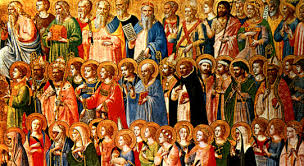
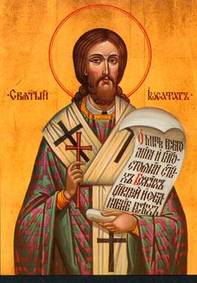
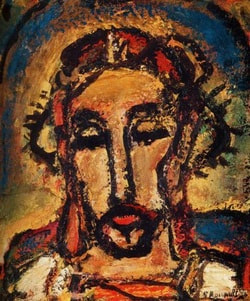

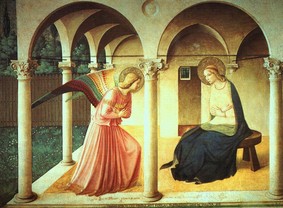
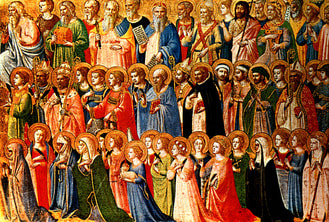
 RSS Feed
RSS Feed